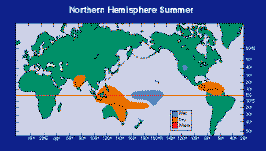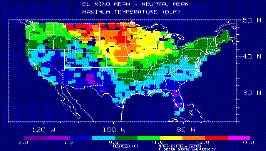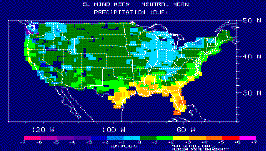
 |
NOAA : PMEL : TAO Project Office : El Niño Theme Page |
| Impacts of El Niño and benefits of El Niño prediction | |
| Contents |
|
Global Consequences of El Niño

Precipitation anomalies during El Niño in (a) Summer and (b) Winter The twists and turns in the ongoing dialogue between ocean and atmosphere in the Pacific can have a ripple effect on climatic conditions in far flung regions of the globe. This worldwide message is conveyed by shifts in tropical rainfall, which affect wind patterns over much of the globe. Imagine a rushing stream flowing over and around a series of large boulders. The boulders create a train of waves that extend downstream, with crests and troughs that show up in fixed positions. If one of the boulders were to shift, the shape of the wave train would also change and the crests and troughs might occur in different places. Dense tropical rainclouds distort the air flow aloft (5-10 miles above sea level) much as rocks distort the flow of a stream, or islands distort the winds that blow over them, but on a horizontal scale of thousands of miles. The waves in the air flow, in turn, determine the positions of the monsoons, and the storm tracks and belts of strong winds aloft (commonly referred to as jet streams) which separate warm and cold regions at the Earth's surface. In El Niño years, when the rain area that is usually centered over Indonesia and the far western Pacific moves eastward into the central Pacific, as shown on p. 17, the waves in the flow aloft are affected, causing unseasonable weather over many regions of the globe.
Regional Consequences of El Niño (United States) 
Anomalies of Winter (a) temperature and (b) precipitation during El Niño. The impacts of El Niño upon climate in temperate latitudes show up most clearly during wintertime. For example, most El Niño winters are mild over western Canada and parts of the northern United States, and wet over the southern United States from Texas to Florida. El Niño affects temperate climates in other seasons as well. But even during wintertime, El Niño is only one of a number of factors that influence temperate climates. El Niño years, therefore, are not always marked by "typical" El Niño conditions the way they are in parts of the tropics. See List of impacts on the U.S. and List of impacts on other countries. Benefits of El Niño PredictionScientists are now taking our understanding of El Niños a step further by incorporating the descriptions of these events into numerical prediction models (computer programs designed to represent, in terms of equations, processes that occur in nature). Such models are fed information, mostly in the form of sets of numbers, describing the present state of the atmosphere-ocean system (for example, observations of wind speeds, ocean currents, sea level, and the depth of the thermocline along the equator). Updated sets of numbers, which the models produce, indicate how the atmosphere-ocean system might evolve over the next few seasons or years. The results thus far, though by no means perfect, give a better indication of the climatic conditions that will prevail during the next one or two seasons than simply assuming that rainfall and temperature will be "normal." Peru provides a prime example of how even short term El Niño forecasts can be valuable. There, as in most developing countries in the tropics, the economy (and food production in particular) is highly sensitive to climate fluctuations. Warm (El Niño) years tend to be unfavorable for fishing and some of them have been marked by damaging floods along the coastal plain and in the western Andean foothills in the northern part of the country. Cold years are welcomed by fishermen, but not by farmers because these years have frequently been marked by drought and crop failures. Such cold years often come on the heels of strong El Niño years. Hence, Peruvians have reason to be concerned, not only about El Niño events, but about both extremes of the El Niño cycle. Since 1983, forecasts of the upcoming rainy season have been issued each November based on observations of winds and water temperatures in the tropical Pacific region and the output of numerical prediction models. The forecasts are presented in terms of four possibilities: (1) near normal conditions, (2) a weak El Niño with a slightly wetter than normal growing season, (3) a full blown El Niño with flooding, and (4) cooler than normal waters offshore, with higher than normal chance of drought. Once the forecast is issued, farmers representatives and government officials meet to decide on the appropriate combination of crops to sow in order to maximize the overall yield. Rice and cotton, two of the primary crops grown in northern Peru, are highly sensitive to the quantities and timing of rainfall. Rice thrives on wet conditions during the growing season followed by drier conditions during the ripening phase. Cotton, with its deeper root system, can tolerate drier weather. Hence, a forecast of El Niño weather might induce farmers to sow more rice and less cotton than in a year without El Niño. Countries that have taken similar initiatives include Peru, Australia, Brazil, Ethiopia, and India. Although tropical countries have the most to gain from successful prediction of El Niño, for many countries outside the tropics, such as Japan and the United States, more accurate prediction of El Niño will also benefit strategic planning in areas such as agriculture, and the management of water resources and reserves of grain and fuel oil. (See lists of impacts for the globe, the US/North America, and other countries). Encouraged by the progress of the past decade, scientists and governments
in many countries are working together to design and build a
global system for (1) observing the tropical oceans, (2) predicting
El Niño and other irregular climate rhythms, and (3) making routine
climate predictions readily available to those who have need of them for
planning purposes, much as weather forecasts are made available to the
public today. The ability to anticipate how climate will change from one
year to the next will lead to better management of agriculture, water
supplies, fisheries, and other resources. By incorporating climate predictions
into management decisions, humankind is becoming better adapted to the
irregular rhythms of climate.
List of Impacts and Prediction Benefits
|